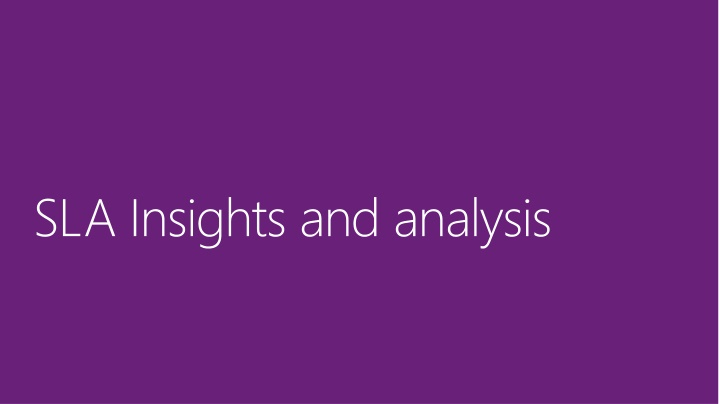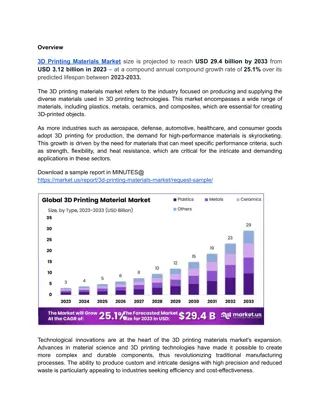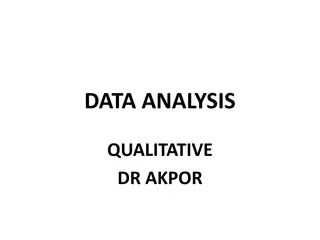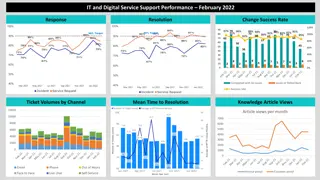SLA Insights and analysis
"Dashboard and on-demand reporting for IT Decision Makers to analyze usage, performance, and costs across cloud resources. Customizable reports provide insights for informed decision-making. Chargeback services optimize infrastructure usage and align capabilities to organizational needs, ensuring efficient resource allocation. Automation streamlines chargeback processes for improved business and technical management."
Download Presentation

Please find below an Image/Link to download the presentation.
The content on the website is provided AS IS for your information and personal use only. It may not be sold, licensed, or shared on other websites without obtaining consent from the author.If you encounter any issues during the download, it is possible that the publisher has removed the file from their server.
You are allowed to download the files provided on this website for personal or commercial use, subject to the condition that they are used lawfully. All files are the property of their respective owners.
The content on the website is provided AS IS for your information and personal use only. It may not be sold, licensed, or shared on other websites without obtaining consent from the author.
E N D
Presentation Transcript
Intelligent Reporting for Better Decisions What does an IT Decision Maker need to make a decision? Dashboard and on-demand reporting: usage and performance on assigned clouds, your workloads, infrastructure costs, trending and forecasting based on enterprise (or individual business unit) projects. Customizable reports. SharePoint Dashboard Price sheet costs Spending trends Private Cloud costs Costs based on user roles Excel dashboard report Price sheets most used Trending of reserved cloud resources Usage per cost center Usage per types of cloud resources 2
Chargeback Service Manager data warehouse Virtual Machine Manager Operations Manager
Chargeback Optimizes Infrastructure Usage Drive management behavior Optimize scarce resources (storage, VMs ) Resources Needs Chargeback Chargeback Technical features IT Provide insight into the cost and usage of services Monitor usage (allocation) Insights through reporting Pricing Business capabilities Planning and insight Building infrastructure
Align Chargeback Capabilities to any Organization Formal Business Technical Informal Resource usage VM usage metering and reporting No pricing Showback Tenant resource usage Cloud based tenant usage metering and reporting No pricing Chargeback Tenant monetized usage Basic pricing Usage-based cost transfer IT financial management Pricing and billing (with SLA) Cost recovery with financial integration and service reports System Center Service Manager R2+ third-party connector System Center Service Manager SP1 Private Cloud Chargeback En Suite defined by cloud tenants & based on allocation Partners: Apptio, Cloud Cruiser and others
Automating Chargeback Services Informal Informal Technical Technical Business Business Chargeback Data warehouse Service Manager Virtual Machine Manager Usage Resources Roles CSPP Portal Analyze data VM Applies quotas Leases from resource pool Approvals Storage Compute Memory Resources (allocation) Developer (business user) $ Apply price sheet Datacenter Admin Formal Formal Excel & Sharepoint Financial management systems Third-party connectors Service Manager Portal 3rdparty web portal Partners: Apptio, Cloud Crusier Generate reports
Set Up Chargeback SCVMM Server and Console installed SCOM Console and Agent installed SCSM Server and Data Warehouse installed and connected Create one or more Clouds Provision or assign VMs to the Clouds Configure integration between SCVMM and SCOM Verify that the right information is exchanged between SCOM and SCVMM
Set Up Chargeback Check that Data Warehouse has been configured and registered Make sure that Excel 2010 or Excel 2013 is installed Import the Chargeback Management Pack Configure the SCOM connector in Service Manager Create a view to see Clouds objects under Configuration Items Configure Price sheet for Chargeback Verify data has moved to data warehouse Use Microsoft tools to analyze data for chargeback
Automating Chargeback Processes Process data Virtual Machine Manager OLAP cubes SQL data marts Operations Manager Service Manager Data mart Data warehouse Load data Reports and dashboards or Access data Store data Get data
Chargeback - Price Sheets VM Base Price per day Cloud Membership Price per day VM CPU Price per core/day VM Memory Price per GB/day Highly Available VM Price per day Static IP Price per day Expanding VHD Price per day
Building a Chargeback Report You have several choices for reporting: reports -- Excel Usage per cost center Usage per types of cloud resources Price sheets most used Activate SharePoint Server Publishing Creating Chargeback Deploying dashboards -- SharePoint Costs based on user roles SharePoint dashboards Private Cloud costs After accessing the Data Warehouse to create OLAP Chargeback Cubes, chargeback data (infrastructure costs and pricing) is available for reporting reports Deploying dashboards through SharePoint Trending of reserved cloud resources Use the Business Intelligence center to enable customized analysis Creating Chargeback Activate PerformancePoint Services Price sheet costs Spending trends Cloud Cost, VM Cost and Total Cost are based on predefined price sheets that IT will set Access data Creating Chargeback reports Deploying dashboards
Traditional Service Management IT Behavior Physical Infrastructure SLA in Weeks & Months Capacity managed by the consumer Consumer Behavior Over-subscribe Under utilize
Cloud Optimized Service Management Pooled resources using Virtual Infrastructure SLA in hours/days Capacity managed by the service provider
Planning Capacity planning Shifts to the Service Provider Capacity planning Shifts to the Service Provider Flexible Cost Models Enabled Flexible Cost Models Enabled Identify Opex: What are my ongoing costs Identify Capex: What are my capital assets Direct costs Indirect costs Fair: One party or individual should not pay for others Transparent: It should be clear to why the cost is applied to a cost model. The bill should be easy to read and understandable by the person who receives the bill. Like in the old days we charged by MIPS, can you quantify the value per MIP? No that is way too difficult to understand what you are being charged for.
& & Proactive Controls Quota Lease Approvals Showback instead of Chargeback Showing who is using what
Expanding Data Insights Across Clouds Moving beyond data about on-premises resources and usage to reporting across clouds Runbooks SS Portal CMDB App Controller SM Portal Service Manager Orchestrator Workflows, Service Offers, Work Items, Templates, Knowledge, Chargeback Information Azure Integration Pack used as a pipeline to external clouds What is being used, when, where and by who What is being requested I need insight into IT services consumed and provisioned in external clouds Rich reports and dashboards For decision makers = 18
Measuring the Datacenter as it Scales Runbooks Health SS Portal CMDB Operations Manager App Controller SM Portal Service Manager Orchestrator Health status of resources, 360 degree monitoring + data useful in trending peak / off-peak usage Automation of process and data collection + Pipeline to external clouds and third-party management via integration packs and requesting resources Processes Workflows, Service Offers, Work Items, Templates, Knowledge, Chargeback Information resources, and use standardized workflows and rules for service management Service requests for resources and compute capacity + data on what is being used Identify clouds with free Development team Reaching compute capacity, 19
Building Deep Insights and Reporting Private Cloud Microsoft Cloud Service Provider Partner enabled Integration Packs Out-of-the-box Orchestrator integration enables Microsoft and third-party platforms to coordinate and use operational data in the infrastructure across varying cloud scenarios (on-premises, Microsoft cloud and service provider clouds) All Systems Center Components Active Directory Exchange (User and Admin) IBM Tivoli Netcool/Omnibus HP (OM, SM, iLO) Windows Azure SharePoint FTP VMware vSphere 20
Single View of Cloud Service Usage Better decisions made on accurate and current data -- better IT planning and usage IT Decision Makers and business unit owners need rich views into the organization s infrastructure Extended Charge for services used, and accurately price new requests management to external clouds Ensure optimal resource availability for key applications & workloads Provide guaranteed levels of service for the key applications and workloads Ensure optimal resource availability for key applications & workloads Take advantage of hardware innovations, while still using existing hardware to maximum advantage Provide guaranteed levels of service for the key applications and workloads





















